United
Nations Headquarters, New York
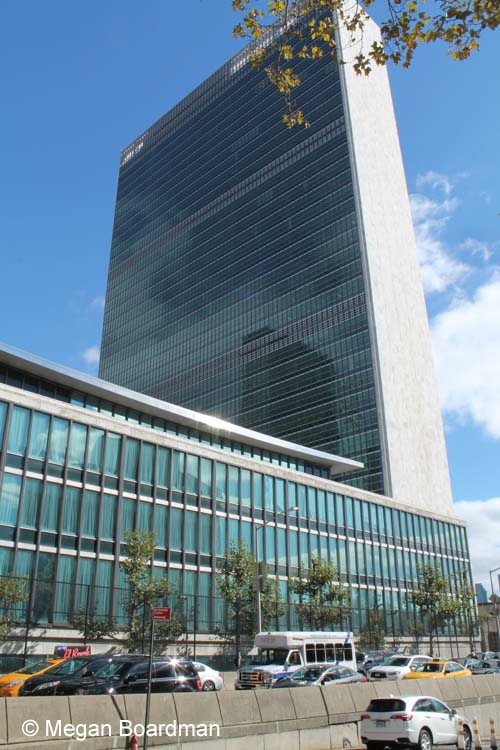
Architect
|
see below
|
Date
Built
|
Secretariat
Building opened in January of 1951
other buildings were added over
time. The Dag Hammarskjold Library
Building was officially dedicated in 1961
|
Location
|
Turtle Bay, New
York
|
Description
|
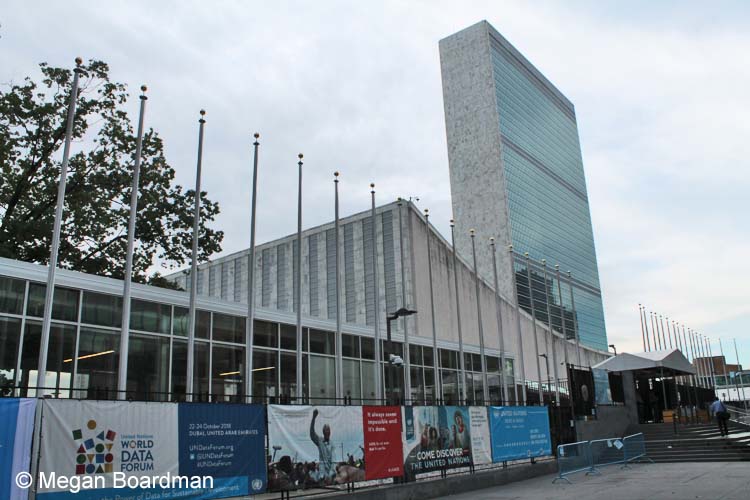
According to the Wikipedia page for the UN
Headquarters, a decision was made not to
hold a competition for the design of the
complex. Instead a multinational team
of famous architects was formed under the
leadership of Wallace Harrison.
Harrison was an American whose practice had
been responsible for the Rockerfeller Centre
and the Lincoln Centre for the Performing
Arts. The team included N. D. Bassov
from the Soviet Union, Gaston Brunfaut from
Belgium, Ernest Cormier (Canada), Le
Corbusier (France), Liang Seu-cheng (China),
Sven Markelius (Sweden), Oscar Niemeyer
(Brazil), Howard Robertson (United Kingdom),
G. A. Soilleux (Australia), and Julio
Vilamajó (Uruguay). Again, according
to Wikipedia, ".... After much
discussion, Harrison, .... determined
that a design based on Niemeyer's
project 32 and Le Corbusier's project 23
would be developed for the final
project. Le Corbusier's project 23
consisted of a large block containing
both the Assembly Hall and the Council
Chambers near the center of the site
with the Secretariat tower emerging as a
slab from the south. Niemeyer's plan was
closer to that actually constructed,
with a distinctive General Assembly
building, a long low horizontal block
housing the other meeting rooms, and a
tall tower for the Secretariat."
- The General
Assembly Building -

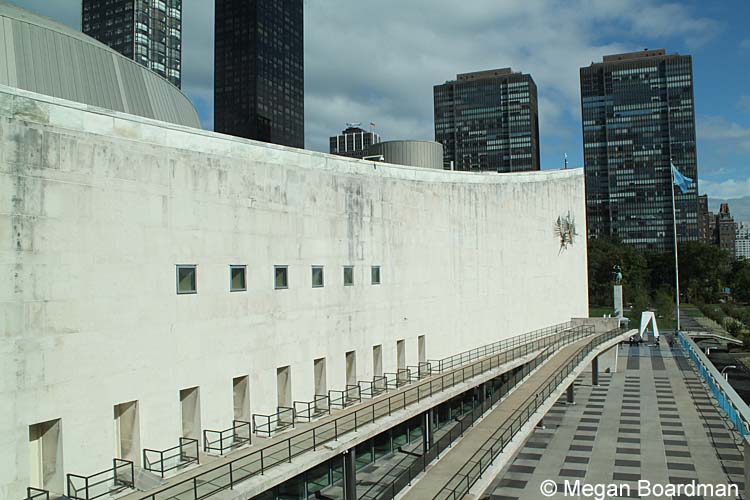

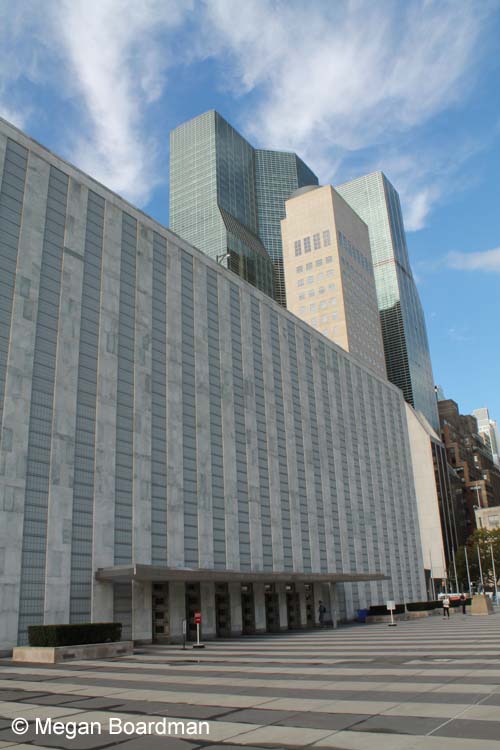


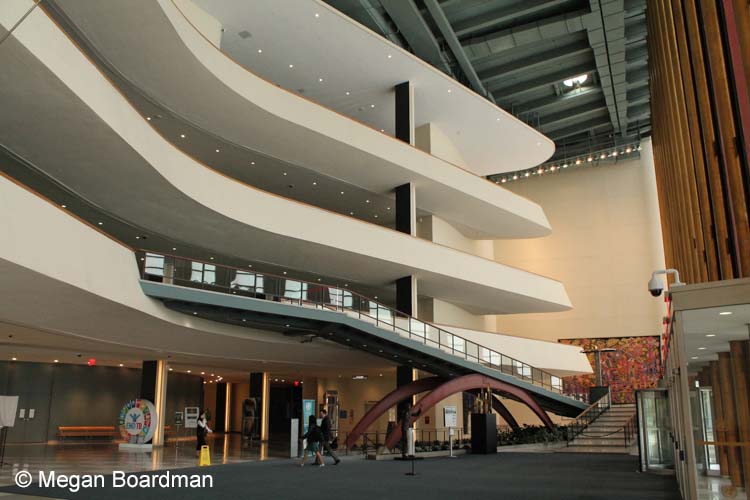
Suspended from the
ceiling, above the stair landing
connecting the lobby with the
second-floor ceremonial entrance to the
General Assembly Hall, is a Foucault
Pendulum.
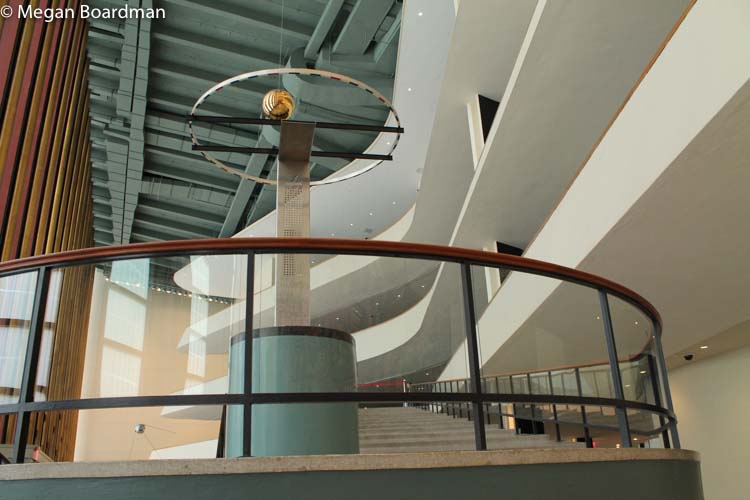
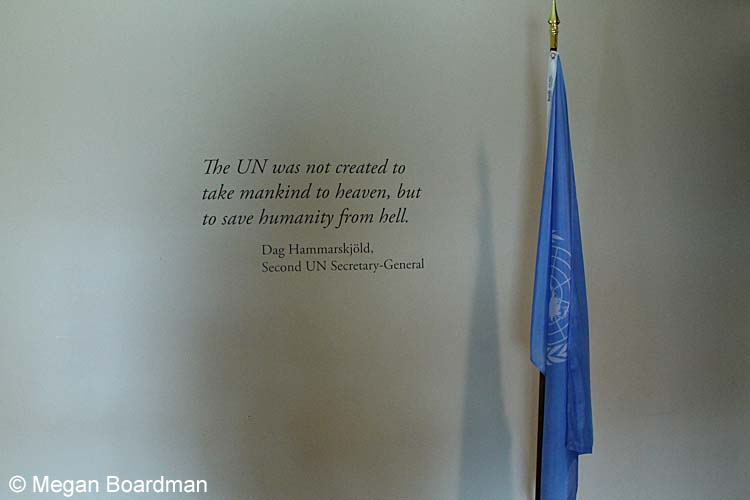 - General Assembly Hall -
- General Assembly Hall -
A United Nations
“Fact Sheet” says of the General
Assembly Hall that it is, “….
165 feet long by 115 feet wide,
with a 75- foot ceiling - (and
it) occupies the second,
third and fourth floors.
Representatives of Member States
sit behind tables facing a raised
speaker's rostrum and podium. From
the viewer’s left to right sit the
Secretary-General of the United
Nations, the President of the
General Assembly, and the
Under-Secretary-General for
General Assembly and Conference
Management. The Assembly
Hall accommodates 193 delegations.
Each delegation has six seats -
three at the tables for full
delegates and three behind them
for their alternates. All
1,898 seats are equipped with
earphones, allowing the listener
to "tune-in" either to the
language being spoken on the floor
or to interpretations into any of
the Assembly's six official
languages -- Arabic, Chinese,
English, French, Russian and
Spanish. The interpreters sit in
glass-walled booths overlooking
the Hall. Television and film
cameramen, broadcasters and other
information personnel, and
official verbatim reporters occupy
similar booths. Above and
behind the speaker's rostrum are
large panels listing the Member
States of the Organization, with
the corresponding results of votes
also displayed. Delegates signal
their country’s vote for or
against a resolution, or their
decision to abstain from a vote,
by pressing green, red or yellow
buttons on the tables in front of
them.”

- Conference Room 4 -
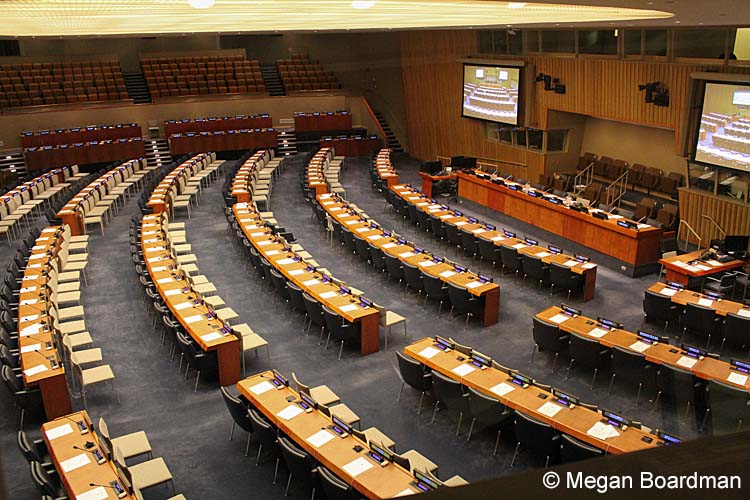
Below: portraits of
the men who have held the post of
Scretary General. The black
wreath around Kofi Annan is because he
had recently passed away.
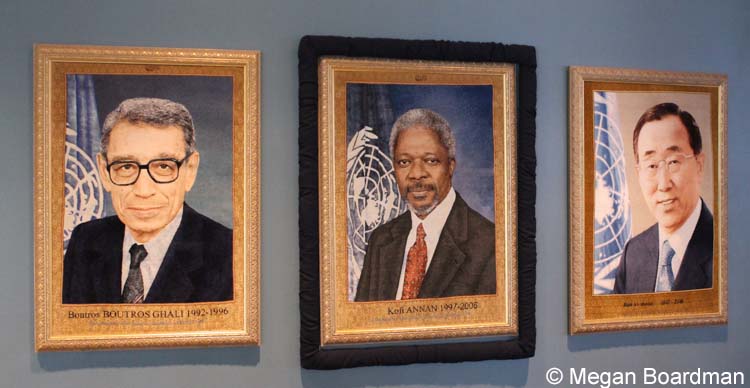
- The Peace Window -
The 'Peace Window’,
by the artist Marc Chagall, was a gift
from the United Nations staff memebers,
as well as Marc Chagall himself,
presented to the United Nations as a
memorial to Dag
Hammarskjøld. The
'Peace Window' was dedicated to his
memory on 17 September 1964, exactly
three years after Dag Hammarskjøld, then
the second Secretary-General of the UN,
and 15 other people with him died in a
plane crash.
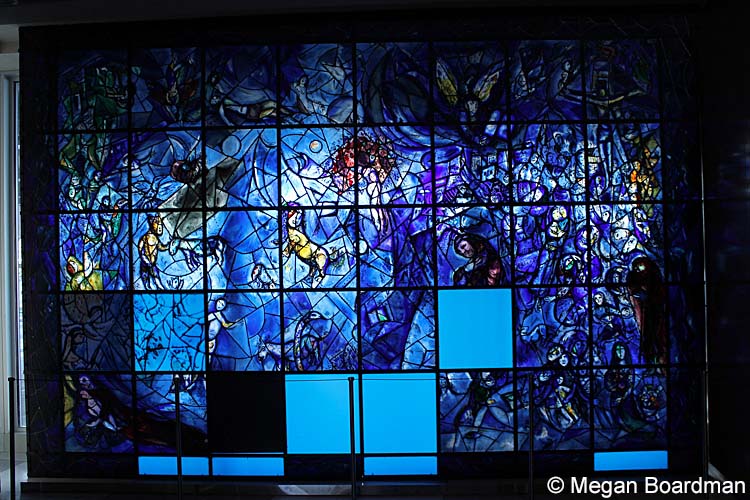
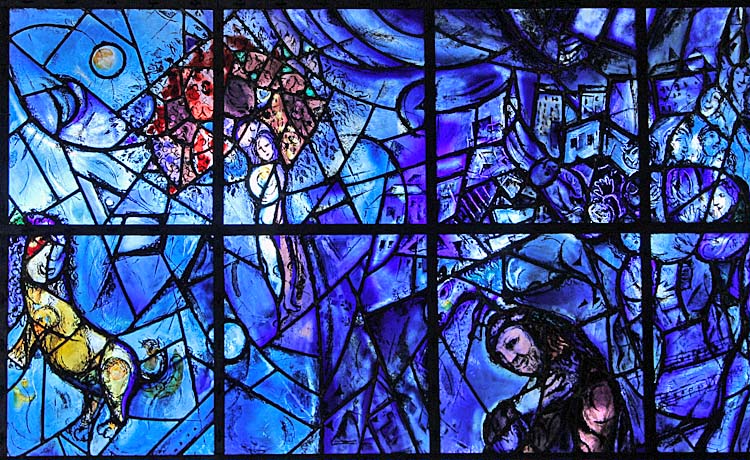
- The Mandela Statue -
This life-size statue
of the late former president of South
Africa, Nelson Mandela, was unveiled at
the United Nations by President
Ramaphosa in 2018 on behalf of the
government and the people of South
Africa. The statue was created by
Andre Prinsloo and Andre Otto.
Prinsloo‚ along with Ruhan Janse van
Vuuren‚ also worked on the nine-metre
bronze Mandela statue that towers over
the gardens at the Union Buildings in
Tshwane. It is fitted with former
President Nelson Mandela’s prison shoes
that he wore during his days as
political prisoner 46664 on Robben
Island in Cape Town, where he served a
jail term of 27 years. In his
address at the unveiling President
Ramaphosa said that, “The statue
is modelled after the day Nelson
Mandela delivered his first speech
to the United Nations Special
Committee on Apartheid on June 22
1990. He urged the United Nations to
maintain sanctions against South
Africa until apartheid was
abolished‚” The
unveiling took place on the 100th
anniversary of Mandella's birth.
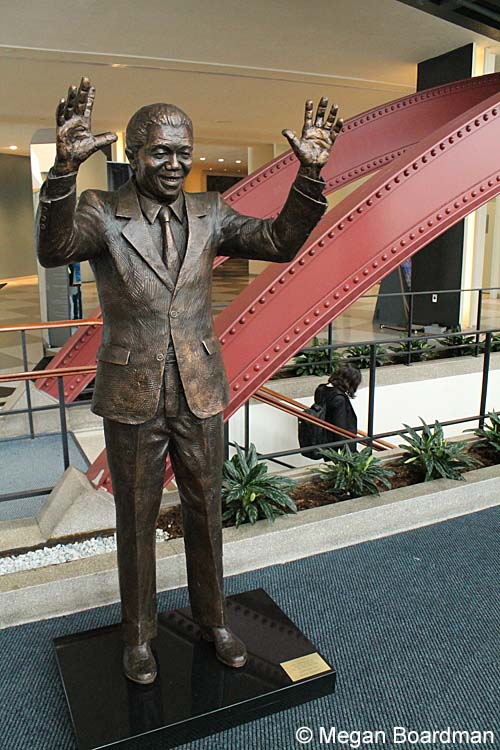
- The Dag
Hammarskjöld Library -
"A new library
building for the UN headquarters was
proposed in 1952. .... The new
facility was slated to cost $3
million. By 1955, the
collection was housed in the
Secretariat Building and held
250,000 volumes in "every language
of the world", according to The New
York Times. The Dag
Hammarskjöld Library Building,
designed by Harrison and Abramovitz,
was officially dedicated in November
1961."
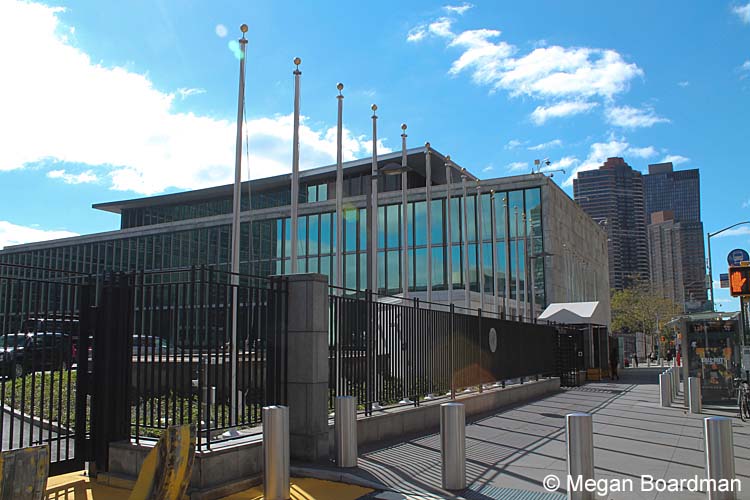
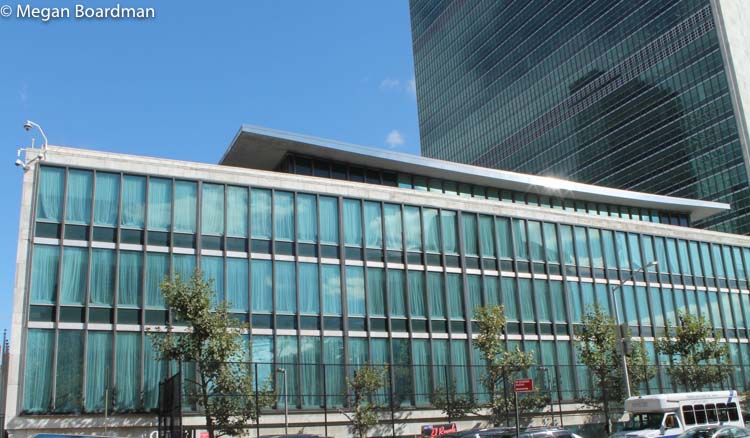
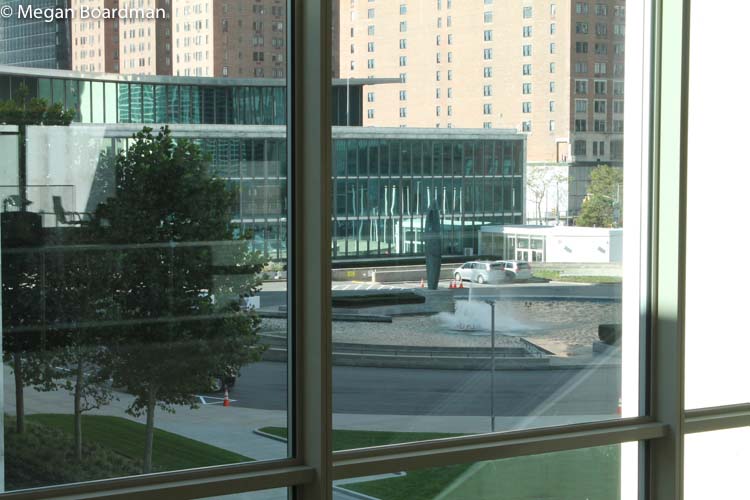
**********************************
- The Security Council Chamber
-
The UN
website explains that, ".... The
Security Council Chamber was
furnished by Norway and designed by
leading Norwegian architect,
Arnstein Rynning Arneberg, and it’s
easily identified by its central
horseshoe-shaped table. A large
mural by Norwegian artist, Per
Lasson Krohg, symbolizing the
promise of future peace and
individual freedom, dominates the
east wall."
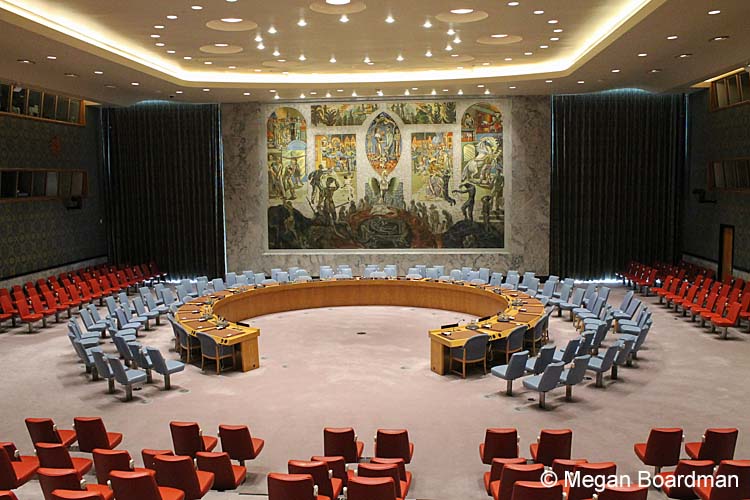
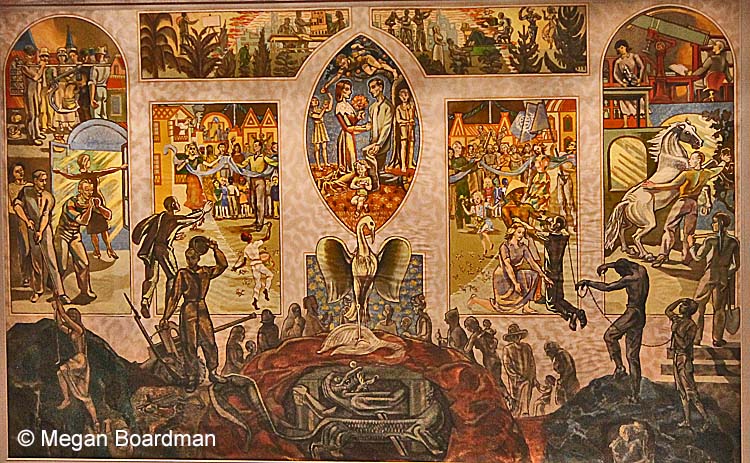
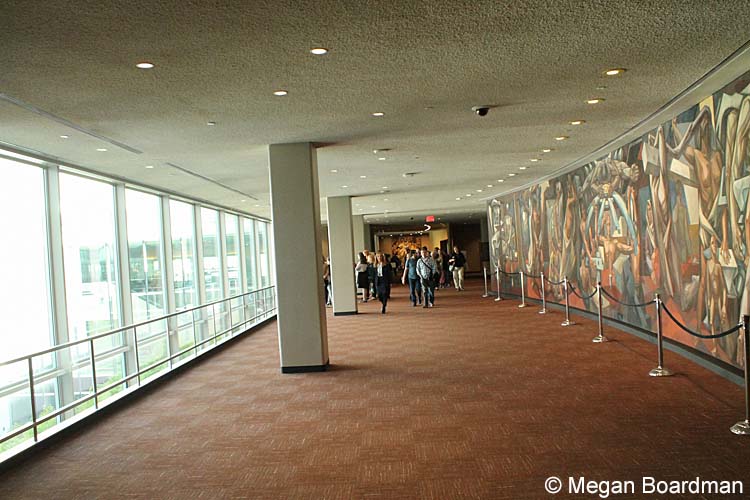 - Economic and Social Council Chamber -
- Economic and Social Council Chamber -
This Chamber was a
gift from Sweden, and designed by the
famous Swedish architect Svem Markelius.
It was renovated in 2013. The
Chamber features a large orange and
white curtain that hangs along the
window wall. Designed by the
artist Ann Edholm it was installed
in 2016 and is entitled ‘Diaologos’.
Apparently, according the the artist,
".... it should make the UN leaders
willing to make decisions.”
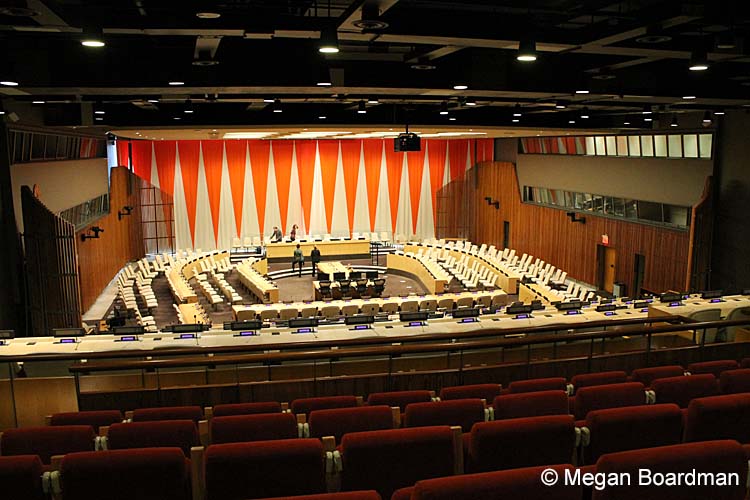 - The sculpture Non-Violence -
- The sculpture Non-Violence -
The iconic sculpture
of a gun with its barrel tied in a knot,
has the official title of “Non
Violence”. It’s come to symbolize
the UN’s commitment to world
peace. It was created by the
Swedish sculptor and painter, Carl
Fredrik Reuterswärd. the
“news.artnet.com" website explains that,
“… Non-Violence was created after
the artist’s friend, John Lennon,
was killed outside his apartment
building in December of 1980.
Commissioned by Lennon’s partner,
Yoko Ono, it was first installed in
1988 outside of New York’s United
Nations building, at a ceremony
attended by Reuterswärd, Yoko Ono,
and the UN Secretary General at the
time, Javier Pérez de Cuéllar.”

|
Close
Window

|



